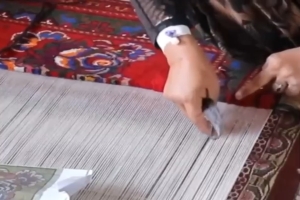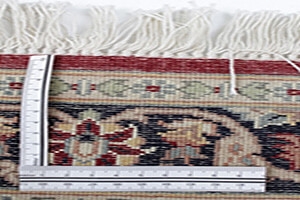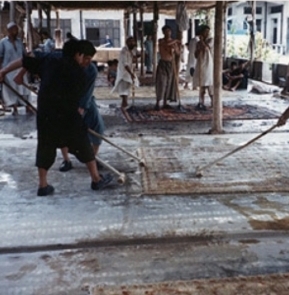How to tell if a carpet is handmade

Handmade carpets are luxurious pieces of home furnishings that are more than just floor coverings. They reflect the rich history of craftsmanship, the intricate design process and the personal dedication of skilled carpet weavers. But how can you tell if a carpet is hand-knotted? To understand this, we need to delve deeper into the world of carpet making.
How do you tell if a carpet is handmade or machine-made?
The first step is to examine the knots. The knots in a Handmade carpet are usually uneven and unorganised, whereas the knots in a machine made carpet are regular and even. In addition, if the knots on the back of the carpet appear to be hand knotted, it is probably a hand knotted carpet. The beauty and uniqueness of the fringes at the bottom of the carpet also indicate the authenticity of a handmade carpet. There is bound to be a flaw in the design and knotting of a hand knotted rug. The higher the knot density, the more valuable the rug. Knot density is measured by the number of knots per square centimetre of carpet.

What does knot density mean in oriental rugs?
The quality of oriental carpets is determined by a number of factors, such as the raw materials, the quality of the craftsmanship and the durability. There are several factors to consider when choosing a high quality carpet. For example, the knot density (knots per square metre) is an important indicator: the higher the number of knots per square metre, the better the quality of the carpet. Some Persian rugs, such as those from Tabriz or Isfahan, can contain up to one million knots per square metre. The knot density can be easily checked by turning the carpet over and counting the number of knots in a 1 cm section along its length and width, multiplying the two results by each other and multiplying the result by 10,000.
-
Low knot density (approx. 50 000-150 000 knots/m²): coarser weave, simpler pattern, less detail.
-
Medium knot density (approx. 150 000-500 000 knots/m²): Better quality, more detailed pattern, more durable carpet.
-
High knot density (500 000-1 000 000 000 knots/m²): Finely detailed patterns, luxury quality, extremely durable.
-
Extremely high knot density (1 000 000+ knots/m²): Handmade, typical of silk rugs, exceptional artistic value.

How can you tell if a carpet is handmade by its pattern and material?
Handmade carpets are usually made of natural materials such as wool, silk or cotton. Natural materials often have a better feel than synthetic materials and are more resistant to time. It is worth examining the fibres and the material of the carpet to determine its authenticity and quality. Handmade carpets often have intricate, unique patterns. The symmetry and precision of these patterns is not perfect, which indicates that the carpet is handmade. The various symbols and motifs in the designs may also refer to the culture and history of the carpet making. The colour shades of handmade carpets are usually variable The variation in colour shades of handmade carpets is natural, as it is obtained during the final washing process. In machine made carpets, the colours are generally uniform throughout.

Determining the origin of an oriental carpet
Identifying the origin of oriental carpets is crucial, as different regions use different weaving techniques, patterns and materials. The country or region where a rug was made can have a significant impact on its value, style and originality. Several key factors help to determine the origin of a carpet, starting with the knotting density and weaving style. Persian carpets (such as those from Tabriz or Isfahan) typically have a high knot density, sometimes reaching one million knots per square metre, and are renowned for their precise and detailed designs. In contrast, Turkish carpets, particularly from areas such as Hereke and Oushak, use a unique double-knot technique known as Ghiordes knotting, which distinguishes them from the single-knot (Senneh) methods of Persian carpets. Carpets from Afghanistan and Pakistan tend to have a coarser weave, coupled with bold geometric designs.
In addition to the patterns and motifs, the colour palettes provide important clues as to the origin of the carpet.
-
Persian carpets often feature floral and curvilinear designs, with intricate medallions and ornate borders. Shades of deep red, navy blue and ivory, derived from natural dyes, are often used.
-
Turkish carpets typically feature bold, angular geometric designs in vibrant colours. Rich shades of gold, orange and deep red are favoured.
-
Afghan rugs are recognisable by their tribal motifs, stylised animal figures, geometric patterns and striking use of deep burgundy or brown and blue colours.
-
Chinese carpets tend to feature large central medallions accompanied by soft pastel colours such as beige, gold and subtle blues. They often feature dragons or delicate floral elements.
The materials used to weave the carpet also provide important clues. Silk Persian carpets, especially from cities such as Qom or Nain, are highly prized for their luxurious texture and lustre. Wool rugs predominate in Afghanistan, Pakistan and Turkey, reflecting the availability of the local fabric. The weft of Persian and Turkish rugs is usually cotton, with occasional goat or camel hair in tribal rugs.
By carefully analysing the knot density, weaving styles, patterns, colour palettes and materials, experts can determine the origin of an oriental rug and authenticate its provenance.
The value of a hand knotted carpet
Last but not least, the value of hand knotted carpets increases over time, while the value of machine knotted carpets decreases. A well maintained hand knotted carpet is an investment that can serve its owner for many years. Just think of antique carpets, which are very valuable.
Identifying a handmade carpet is not always easy, but the tips mentioned above can help you with the task. Such carpets can be a luxurious addition to your home and can serve for many years to come. After all, a hand knotted carpet is not just a carpet, it is art, history and culture. Man-made carpets are amazing. Even a single carpet is made up of hundreds of thousands of knots, each one made by the hand of an artist. These carpets can serve for many years and remain beautiful if well cared for. So, the next time you're shopping for a carpet, examine the knots, the material and the pattern, and you too may find the perfect hand-knotted carpet for your home.
Certificate of origin for our oriental carpets
We are pleased to welcome you as the owner of unique and carefully selected pieces from our Oriental rug collection. For us, it's not just a rug; each piece is a work of art, backed by centuries of tradition and authentic handmade art. It is in this context that we would like to show the importance of the certificate of origin that you receive when you buy an oriental rug.
Why is a Certificate of Origin important?
A Certificate of Origin is an official document that certifies the origin, quality and the manufacturing technique used to make an Oriental rug. This certificate serves as a guarantee that you have purchased a genuine, authentic oriental rug and not a mass-produced or counterfeit version. The document also details the material of the oriental rug, the type of fibres, the density of the knotting, the origin of the dyes and the design features.
What does the Certificate contain?
Place of production: the exact place of origin of the carpet, often a specific city or region.
Materials: the raw materials used, such as wool, silk, cotton
Manufacturing technique: e.g. hand knotting, hand weaving
Knotting density: Number of knots per square metre.
Dyes: use of natural or synthetic dyes.
Design and motifs: Names of the patterns and symbols used, which are often part of a particular culture or tradition.
How to Use the Certificate?
A certificate of origin is not only a proof of the authenticity of an oriental rug; it is also a document that adds value. If the Oriental rug is to be sold, the certificate can help to establish its market value. It can also be useful for caring for the carpet, as knowledge of the materials and the manufacturing techniques will help to choose the right cleaning products and methods.
Read about cleaning and care of oriental carpets in our article. We also offer a 12-month warranty on all our oriental rugs.
